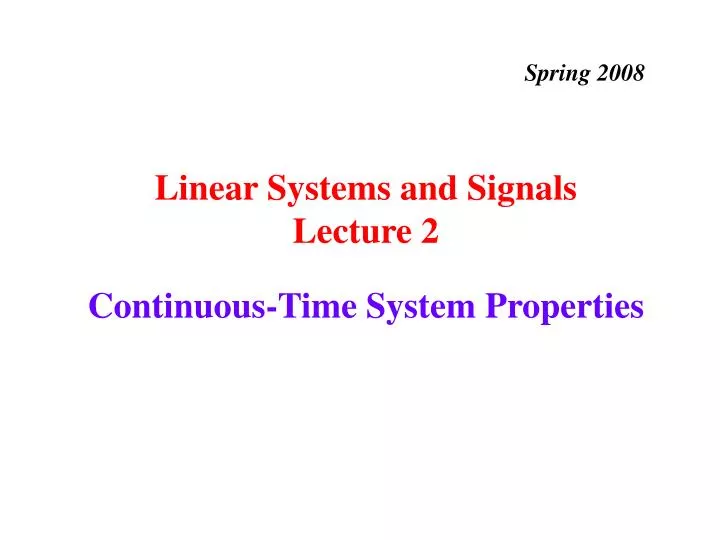Frequency Analysis of Continuous Time System Ppt
![]() Download
Download

Skip this Video
Loading SlideShow in 5 Seconds..
Continuous-Time System Properties PowerPoint Presentation


Continuous-Time System Properties
Download Presentation
Continuous-Time System Properties
- - - - - - - - - - - - - - - - - - - - - - - - - - - E N D - - - - - - - - - - - - - - - - - - - - - - - - - - -
Presentation Transcript
-
Spring2008 Continuous-Time System Properties Linear Systems and SignalsLecture 2
-
Linearity • A system is linear if it is both • Homogeneous: If we scale the input, then the output is scaled by the same amount: • Additive: If we add two input signals, then the output will be the sum of their respective outputs • Response of a linear system to zero input?
-
y(t) x(t) y(t) x(t) x(t) y(t) x(t) y(t) Examples • Identity system. Linear? • Ideal delay by T seconds. Linear? • Scale by a constant (a.k.a. gain block). Linear? • Two different but equivalent graphical syntaxes
-
Examples • Tapped delay line • Linear? Each T represents a delay of T time units … There are N-1 delays … Continuous Time System S
-
Examples • Transcendental system • Answer: Nonlinear (in fact, fails both tests) • Squarer • Answer: Nonlinear (in fact, fails both tests) • Differentiationis linear • Homogeneity test: • Additivity test: y(t) x(t)
-
y(t) x(t) Examples • Integration • Homogeneity test • Additivity test • Answer: Linear • Human hearing • Responds to intensity on a logarithmic scale • Answer: Nonlinear (in fact, fails both tests)
-
Examples • Human vision • Similar to hearing in that we respond to the intensity of light in visual scenes on a logarithmic scale. • Answer: Nonlinear (in fact, fails both tests) • Modulation by time • Answer: Linear
-
Examples • Amplitude Modulation (AM) but not AM radio y(t) = Ax(t) cos(2 p fc t) fc is the carrier frequency (frequency of radio station) A is a constant • Answer: Linear y(t) x(t) A cos(2 p fc t)
-
Examples • Frequency Modulation (FM) • FM radio: • fc is the carrier frequency (frequency of radio station) • A and kf are constants • Answer: Nonlinear (fails both tests) Linear Linear Linear Nonlinear Linear kf A x(t) + y(t) 2pfct
-
y(t) x(t) System yshifted(t) x(t – t0) Time-Invariance • A system is time-invariant if • When the input is shifted in time, then its output is shifted by the same amount • This must hold for all possible shifts. • If a shift in input x(t) by t0causes a shift in output y(t) by t0 for all real-valued t0, then system is time-invariant: Does yshifted(t) = y(t – t0) ?
-
Examples • Identity system • Step 1: compute yshifted(t) = x(t – t0) • Step 2: does yshifted(t) = y(t – t0) ? YES. • Answer: Time-invariant • Tapped Delay Line • Answer: Time-invariant
-
Examples • Transcendental system • Answer: Time-invariant • Squarer • Answer: Time-invariant • Differentiator • Answer: Time-invariant
-
Examples • Integration • Answer: Time-invariant • Human hearing • Answer: Time-invariant • Human vision • Answer: Spatially-varying
-
Time-invariant Time-varying x(t) A y(t) cos(2pfct) Time-invariant Time-invariant Time-varying Time-invariant Time-invariant kf A x(t) + y(t) 2pfct Examples • Amplitudemodulation(not AM radio) • FMradio
-
Memoryless • A mathematical description of a system may be memoryless, but an implementation of a system may use memory.
-
Example #1 • Differentiation • A derivative computes an instantaneous rate of change. Ideally, it does not seem to depend on what x(t) does at other instances of t than the instant being evaluated. • However, recalldefinition of aderivative: • What happens at a pointof discontinuity? We couldaverage left and right limits. • As a system, differentiation is not memoryless. Any implementation of a differentiator would need memory. x(t) t
-
Sampler lowpassfilter quantizer 1/T Example #2 • Analog-to-digital conversion • Lecture 1 mentioned that A/D conversion would perform the following operations: • Lowpass filter requires memory • Quantizer is ideally memoryless, but an implementation may not be
-
Causality • System is causal if output depends on current and previous inputs and previous outputs • When a system works in a time domain, causality is generally required • For images, causality is not an issue when the entire image is available because we could process pixels from upper left-hand corner to lower right-hand corner, or vice-versa
-
Summary • If several causes are acting on a linear system, then the total effect is the sum of the responses from each cause • In time-invariant systems, system parameters do not change with time • For memoryless systems, the system response at any instant t depends only on the present value of the input (value at t)
-
Summary • If a system response at t depends on future input values (beyond t), then the system is noncausal • A signal defined for a continuum of values of the independent variable (such as time) is a continuous-time signal • A signal whose amplitude can take on any value in a continuous range is an analog signal
Source: https://www.slideserve.com/anevay/continuous-time-system-properties
0 Response to "Frequency Analysis of Continuous Time System Ppt"
Post a Comment